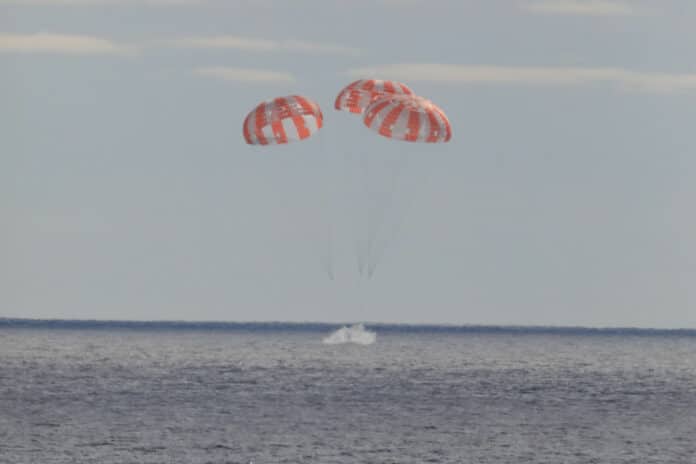NASA’s Artemis 1 lunar mission ended in a splashdown of the uncrewed Orion spacecraft in the Pacific Ocean, west of Baja California, at 9:40 am PST Sunday. During its record-breaking mission, the astronaut ship traveled more than 1.4 million miles on a path around the Moon and returned safely to Earth, completing the Artemis I flight test.
The splashdown is the final milestone of the Artemis I mission that began with a successful liftoff of NASA’s Space Launch System (SLS) rocket from Launch Pad 39B at the Kennedy Space Center in Florida on November 16. Over the course of 25.5 days, NASA tested the components of the Orion capsule in the harsh environment of deep space before flying astronauts on Artemis II.
Orion performed two lunar flybys, coming within 80 miles of the lunar surface during the mission. At its farthest distance during the mission, the spacecraft traveled nearly almost 270,000 miles (434,500 km) from the Earth, more than 1,000 times farther than where the International Space Station orbits Earth, to intentionally stress systems before the flying crew.
During the ultrasonic re-entry, Orion endured temperatures about half as hot as the surface of the Sun at about 5,000 °F (2,760 °C). Within about 20 minutes, Orion slowed from nearly 25,000 mph (40,233 km/h) to about 20 mph (32 km/h) for its parachute-assisted splashdown. During the flight test, Orion stayed in space longer than any spacecraft designed for astronauts has done without docking to a space station. While in a distant lunar orbit, Orion surpassed the record for distance traveled by a spacecraft designed to carry humans, previously set during Apollo 13.
With splashdown, NASA has successfully operated Orion in the deep space environment and demonstrated that Orion could withstand the extreme conditions of returning through Earth’s atmosphere from lunar velocities. Recovery teams are now working to secure Orion for the journey home.
In the coming days, Orion will return to shore, where technicians will offload the spacecraft and transfer it by truck back to Kennedy, where NASA and contractor engineers will evaluate the effects of the flight on the capsule and the three mannequins that stood in for live astronauts. Next, the capsule and its heat shield will undergo testing and analysis over the course of several months.
“The splashdown of the Orion spacecraft – which occurred 50 years to the day of the Apollo 17 Moon landing – is the crowning achievement of Artemis I. From the launch of the world’s most powerful rocket to the exceptional journey around the Moon and back to Earth, this flight test is a major step forward in the Artemis Generation of lunar exploration,” said NASA Administrator Bill Nelson. “It wouldn’t be possible without the incredible NASA team. For years, thousands of individuals have poured themselves into this mission, which is inspiring the world to work together to reach untouched cosmic shores. Today is a huge win for NASA, the United States, our international partners, and all of humanity.”
